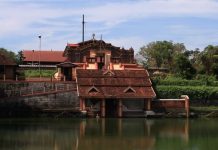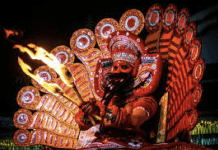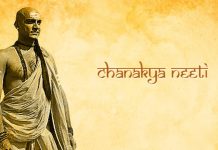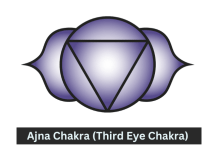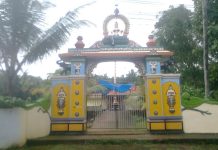
Veerateeswarar Temple is dedicated to Lord Shiva and it is located in Thiruvathigai village which is about 2 kilometres east from the town of Panruti in the Tamil Nadu state. Lord Shiva is worshiped as Veerattaaneswarar, and is represented by the lingam. His consort Parvati is depicted as Thiripurasundari. The presiding deity is revered in the 7th century Tamil Saiva canonical work, the Tevaram, written by Tamil saint poets known as the nayanars and classified as Paadal Petra Sthalam.
Legend
According to the legend, Lord Shiva destroyed three rakshashas and the three cities created by them in this place. Saranarayana Perumal (Lord Vishnu) had given the arrow to Shiva for killing the demons. Shiva Purana details the legend of destruction of the demon Tripuran, who was ruling Tripura. The destruction is detailed as a cosmic event, which most attribute to the destruction of stars, meteors and unexplained material bodies. Tripuran attacked all the celestial deities who sought the help of Shiva to protect them. Shiva after a fiery fight, destroyed Tripuran and attained the name Tripurantaka. Shiva ashed down the city Tripura and dipped his three fingers in the ashes, which signifies the three lines of ash which is worn by all shaivites on their forehead.
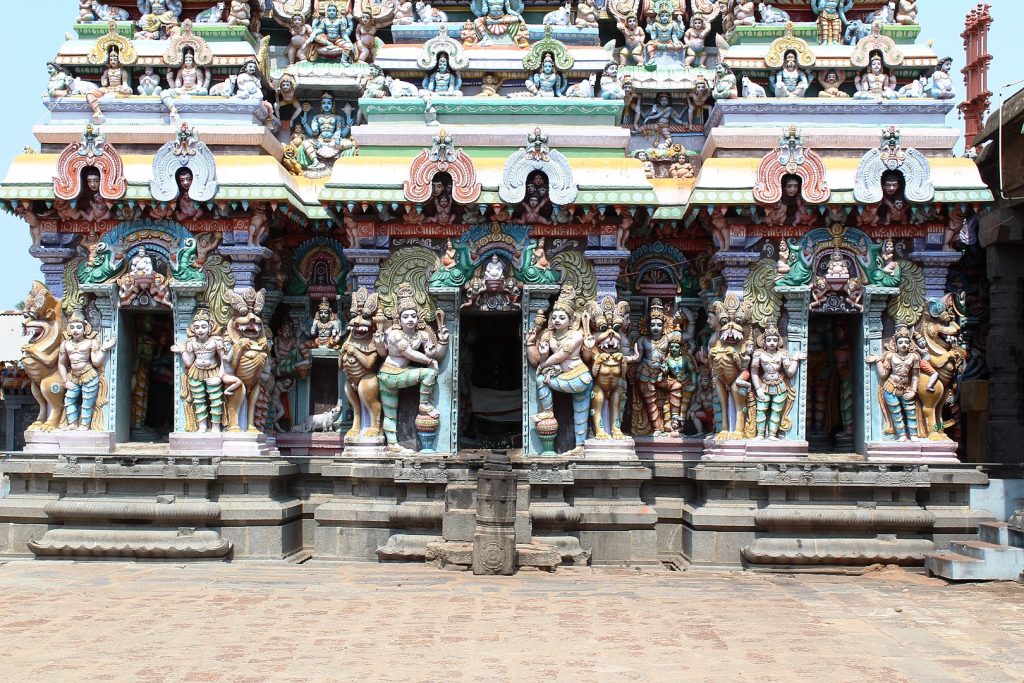
History
The Pallava king Mahendravarman I built a temple called Gunavareswaram close to the temple. Mahendra Pallava is believed to have attained the name Gunavareswara on account of the incident. A king called Kalinkaraya is believed to have endowed lot of treasures and built various structures in the temple as seen from the inscriptions in the temple. King Raja Raja Chola I is believed to have stayed in this temple for a long time to study the architecture before building Brihadeeswarar Temple. The temple is believed to have been expanded by later Pandyas. During the period of Marthas and British Colonization, the temple acted as a fort to the armies. The inscriptions indicate that the streets have to be cleaned before any temple procession with the likes of the streets in this village.
Architecture
The temple covers an area of 7 acres with three precincts. The seven tiered Vimana or gateway tower has sculptures depicting 108 poses of Bharatanatyam. There is a sixteen pillared hall called Thiruneetru mandapam. There is a temple tank named Chakrateertha kulam and a Vasantha mandapam on the northern portion of the tank. On the second precinct, there is a flag staff and a five tiered temple tower. The sanctum is built on an elevated structure. There are shrines around the sanctum in the first precinct that has a shrine of Thilagavathiar, a pillared hall housing the sixty three nayanmar, Saniswarar, Durga, Siddivinayagar, Muruga, a set of Lingam, Nataraja and Surya. The shrine of Umayammai, the consort of the presiding deity, is present. The shrine houses the image of Lingam which is believed to have worshiped by Vishnu. There is a south facing shrine in the hall before the sanctum where the image of Tripurasamharamurthy with sixteen hands is housed. Sanctum houses the image of Veerataneswarar in the form of lingam. There is an image of Ammayapar housed in the sanctum. The shrine over the sanctum has a pyramidal roof with stucco images all through the filial at the top.
Festivals
There are weekly rituals like somavaram and sukravaram, fortnightly rituals like pradosham and monthly festivals like amavasai (new moon day), kiruthigai, pournami (full moon day) and sathurthi.
The most famous festivals of the temple are
- 10 days Vasantha Utsavam celebrated during the Tamil month of Chittirai (April-May).
- 10 day Vaikasi Brahmotsavam celebrated during the Tamil month of Vaikasi (May – June)
- 10 day Aadi Pooram; 10 day Manickavasagar utsav in Margazhi, 1 day Margazhi Tiruvadhirai with Theerthavari etc
Temple Timings:
The temple is open from 6.00 a.m. to 12.00 a.m. and from 5.00 p.m. to 8.00 p.m.
Pooja Timings:
The temple priests perform the pooja (or rituals) during festivals and on a daily basis. The temple rituals are performed six times a day;
- Ushathkalam at 6:00 a.m.
- Kalasanthi at 8:00 a.m.
- Uchikalam at 12:00 p.m.
- Sayarakshai at 6:00 p.m.
- Irandamkalam at 8:00 p.m. and
- Ardha Jamam at 9:00 p.m.
Each ritual comprises four steps: abhisheka (sacred bath), alangaram (decoration), neivethanam (food offering) and deepa aradanai (waving of lamps) for both Veerateeswarar and Thiripurasundari.
How to Reach:
By Air:
Nearest Airports are located at Chennai (165 Kms) and Trichy (167 Kms).
By Rail:
Nearest Railway Station is located at Panruti (2 Kms). Buses and Taxis are available to reach this temple from Panruti Railway Station.
By Bus:
Nearest Bus stand is located at Panruti (2 Kms). Panruti to temple bus services are available.



